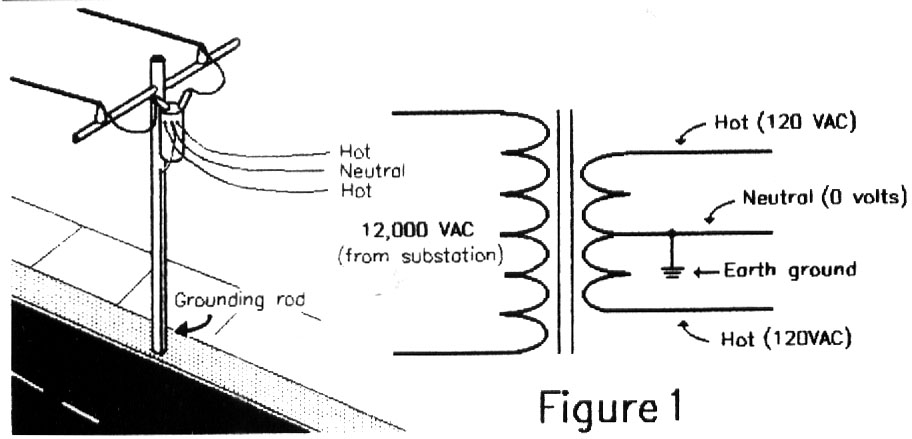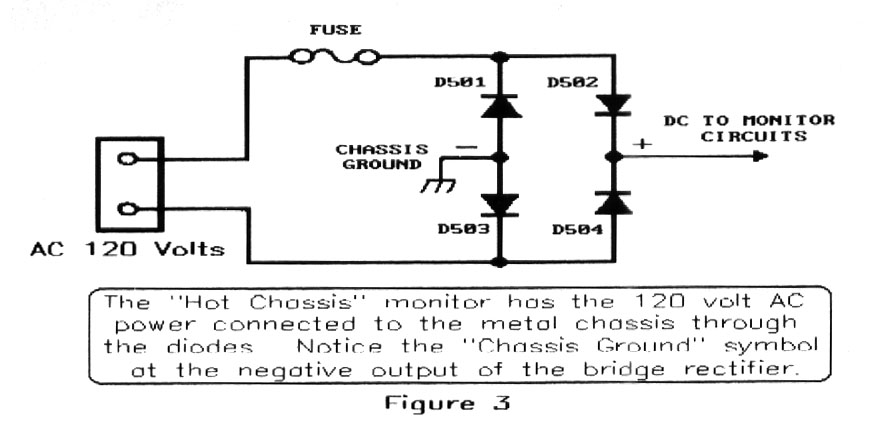Arcade School
Live classes held nationwide

Instructional Videotape and Book Information and On-Line Order Form

|
By Randy Fromm
I get a lot of questions about isolation transformers.
Just about everyone knows that the monitor in a videogame must get its
power through an isolation transformer but many confess that they don't
fully grasp the reasons why. After all, the isolation transformer uses
120 volts AC as an input and produces 120 volts AC as an output. It seems
silly doesn't it? Why not connect the monitor directly to the 120 volts
that comes through the line cord in the game?
 To get a better understanding of isolation, we need to take a look at the way the AC power distribution system works. In a typical overhead power system, the wires carry 12,000 volts AC from the generating facility or substation. A pole mounted transformer is used to step the voltage down. The output of the transformer is a center-tapped, step-down winding that has just one turn of wire for every fifty turns of wire on the input winding. This 50:1 ratio is known as the "turns ratio" and it's the turns ratio that determines the output voltage of a transformer. In this case, the transformer on the pole receives a 12,000 volt AC input and produces a 240 volt AC output. The center-tap allows the 240 volt AC output to be split into two, 120 volt AC outputs. The center-tap of the transformer is known as the "neutral" connection. It is electrically neutral, having neither positive nor negative voltage. The neutral connection is always at 0 volts and provides the "return-path" for the alternating current. The two outside leads are called "hot" connections. It is from the hot connections that we get our 120 or 240 volts AC. At each pole-mounted transformer, the neutral
connection is grounded. As the name implies, "grounding" means connecting
the neutral lead of the transformer to the Earth itself. This is accomplished
by driving a long, metal stake into the dirt at the base of the pole. A
heavy wire runs down the side of the pole, connecting the neutral to the
metal stake. By grounding each transformer, a common reference point is
created for balancing the entire power distribution system. This so-called
"Earth ground" can also provide a measure of defense against shock in case
of electrical failures.
Hot Chassis MonitorNow let's take a look at the monitor and see how it fits in the picture. More specifically, let's look at the bridge rectifier in the monitor's power supply. The 120 volt AC power connects to the bridge rectifier through a fuse (see figure 3). Notice that the negative output of the bridge is connected to the "chassis ground". The chassis ground is not electrically connected to the earth ground in any way.If the monitor is powered  directly from the 120 volt AC line, the metal chassis of the monitor will become
connected through a diode to hot. This is technically known as a (you guessed
it) "hot-chassis" monitor. The entire chassis will have 120 volts on it.
Needless to say, this is a very dangerous situation. If you are connected to
earth ground in any way (by leaning against a grounded control panel or coin
door, for instance) and touch the chassis, you may get a nasty shock.
directly from the 120 volt AC line, the metal chassis of the monitor will become
connected through a diode to hot. This is technically known as a (you guessed
it) "hot-chassis" monitor. The entire chassis will have 120 volts on it.
Needless to say, this is a very dangerous situation. If you are connected to
earth ground in any way (by leaning against a grounded control panel or coin
door, for instance) and touch the chassis, you may get a nasty shock.
So, the hot chassis monitor design presents us with a real safety hazard. But here's another important point to consider. Most videogames have an Earth ground wire that connects to the chassis of the monitor. This earth ground wire comes from the round, earth ground pin in the AC plug. If the earth ground is connected to the hot chassis, it short circuits one of the negative diodes in the bridge rectifier. This causes a massive amount of current to flow through the other negative diode, causing it to fail. It's normal to find one or both of the negative diodes shorted in a situation like this. As a matter of fact, it's just about the only thing that causes these diodes to fail. Most of the time, it's the positive diodes that fail. With the shorted bridge rectifier now drawing enormous current from the 120 volts AC, we discover yet another problem... The earth ground may have bypassed the fuse in the monitor, blowing the main AC fuse in the game or the circuit breaker in the building. There's a 50-50 chance of this happening. If the hot side goes to the fuse, damage to the monitor may be minimized. But if the fuse is connected to the neutral lead instead, it will be completely bypassed by the earth ground that is connected to the chassis. This can cause a lot of damage to the power supply in the monitor, taking out diodes, transistors, resistors and voltage regulators. IsolationWe get around all of the problems associated with the hot-chassis monitor by using an isolation transformer. An isolation transformer has a 1:1 turns ration, producing an output voltage that matches the input voltage. We get 120 volts AC from the output of the transformer but lose the ground. In other words, there is no longer a neutral side that is connected to the Earth. The transformer has a 120 volt AC output that is "isolated" from any connection or reference to the Earth. With the neutral/earth ground connection broken, the chassis of the monitor can be safely grounded without shorting the diodes in the monitor's power supply. Isolation from a ground referenced source of power also reduces the chance of shock.The average videogame monitor draws about
75 watts of power, so an isolation transformer with a one amp rating should
theoretically be able to handle it. However, transformers are only about
80% efficient, with the lost 20% showing up as waste heat. A transformer
can get quite hot to the touch. Obviously, a larger transformer will be
able to distribute the heat through a larger mass and run cooler. This
may prevent premature transformer failure. Also, some people hook up more
than just the monitor to the isolated output of the transformer. It's not
unusual to see the power supply, fan and fluorescent light connected to
the output as well. This will, of course, increase the load on the isolation
transformer. As a matter of fact, the subject of AC power distribution
in videogame conversions will be the subject of next month's soapbox. Suffice
to say that a one amp transformer is acceptable for powering the monitor
alone but a higher rated output of two or more would be better if the cost
is not significantly higher.
|